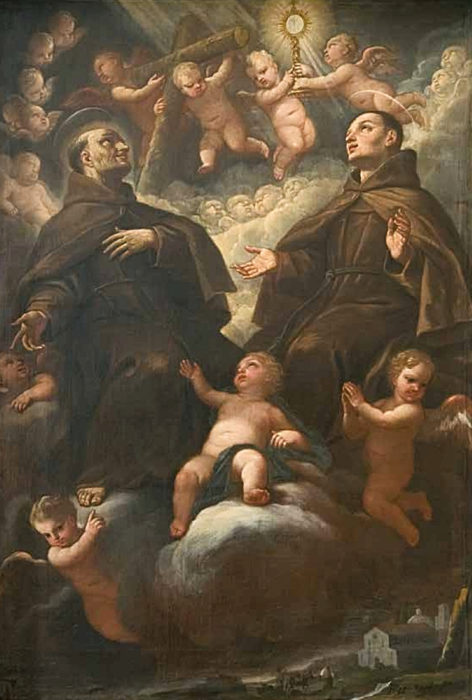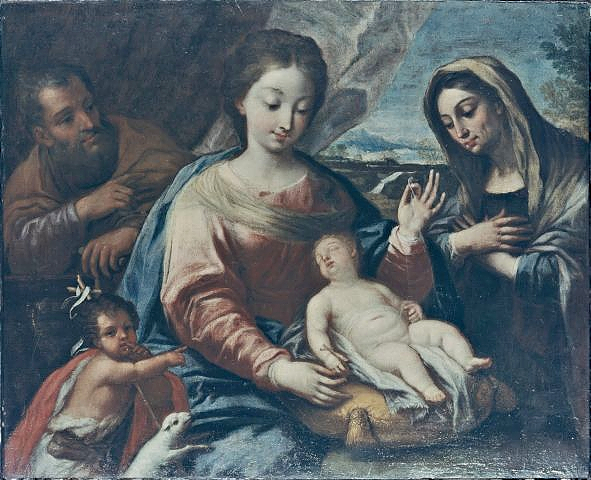Filippo Ceppaluni (c. 1685–1725)
Click on the images to find out more
Born around 1685 to a humble family, the Neapolitan Filippo Ceppaluni entered the workshop of the Maltese-born painter Raimondo de Dominici (1645-1705) at a young age, under whom he became an apprentice. The main source for retracing his career is the biography written between 1742 and 1745 by Bernardo de Dominici (1683-1759), Raimondo’s son, who had a direct acquaintance with Ceppaluni. Bernardo recalls that Filippo was brought up in the house of de Dominici, which suggests room and board in lieu of a salary. His apprenticeship—consisting of the study of compositional models taken from the collection of prints and drawings assembled by Raimondo—lasted approximately until 1698 when De Dominici temporarily left Naples to move to Malta. In 1702, Ceppaluni entered the prestigious workshop of Luca Giordano (1634-1705), who had recently returned to Naples after having spent a decade in Madrid. It is possible that the close ties between Raimondo de Dominici and Luca Giordano facilitated Ceppaluni’s entry into Giordano’s workshop. Giordano took Ceppaluni’s pictorial education to heart, communicating his teaching through gestures.
The first commission attributed to Ceppaluni is the fresco decoration of the ceiling of the church of San Clemente in Pellezzano, near Salerno. Completed in September 1714, the decoration included a central scene depicting the Glory of San Clemente and two minor episodes focused on the Vision of St. Anne and the Madonna of the Rosary. The Pellezzano commission suggests that Ceppaluni, as well as other students of Giordano such as Giuseppe Simonelli and Andrea Malinconico, sought work opportunities in the peripheral areas of Campania and Basilicata, two of Italy’s southern regions. This is confirmed by a canvas signed and dated 1718 for the church of Santa Maria degli Angeli in Avigliano and depicts Saints Peter of Alcantara and Pasquale Baylon. In the period 1721-1723 Ceppaluni completed eight paintings for the church of San Francesco in Forio d’Ischia. Two years after this commission, he died shortly before turning 40.
Bernardo de Dominici celebrates Filippo Ceppaluni’s success as a portrait painter noting that he became one of the most sought after artists in Naples. Although none of his portraits have been traced, archival evidence confirms Ceppaluni’s commissions. To this end, a document dated 28 June 1715 testifies to the payment Filippo received for two portraits made for the Marquis delle Valle and his brother Domenico Mendoza. The inventory of the collection of Nicola Cardinale, dated 1716 lists the portraits of the Prince of Montesarchio, the Count of Galbes and the Countess of Lemos, all made by Filippo Ceppaluni. Similarly, a document referring to the collection of Carlo Antonio Filippo Spinelli, the Prince of Cariate, mentions two further portraits made by the Neapolitan artists.
Bibliography
Di Furia, Ugo. Cinque secoli di presenza artistiche ad Avigliano: personalità e opere. In Avigliano: storia urbana, territorio, architettura, arte. Francesco Manfredi (ed.), Avigliano, 2015, 374-377.
Fontana, Mauro Vincenzo. ‘Il seguito di Luca Giordano in Basilicata e ai suoi confini. Aggiunte al catalogo di Andrea Malinconico, Giuseppe Simonelli, Andrea Miglionico e Filippo Ceppaluni’. Bollettino d’Arte, 99 (22-23), 2014, 151-164.
Costanzo, Salvatore. Pittura tra Malta e Napoli nel segno del Barocco. Da Raimondo il maltese a Bernardo de Dominici. Napoli, 2011, 362-375.
Pavone, Mario Alberto. Pittori napoletani del primo Settecento: fonti e documenti. Napoli, 1997.
De Dominici, Bernardo. Le Vite dei pittori, scultori ed architetti napoletani. Napoli, 1742-1745.


